import numpy as np
def fit(self, X, y, max_steps):
"Fits weights to data until it has reached 'max_steps' iterations or the accuracy equals 1"
X_ = np.append(X, np.ones((X.shape[0], 1)), 1)
self.w = np.random.random(X.shape[1] + 1)
self.history = [self.score(X_, y)]
y_ = 2*y - 1
for _ in range(max_steps):
i = np.random.randint(X.shape[0])
self.w += (y_[i] * (np.dot(X_[i], self.w)) < 0) * y_[i]*X_[i]
self.history.append(self.score(X_, y))
if self.history[-1] == 1:
break Goal
The goal of this blog post is to implement the perceptron, a classic binary linear classifier algorithm. We implement such algorithm in Python, try some experiments and showcase its limitations with data that is not linearly separable. Moreover, at the end we perform a complexity analysis of this algorithm.
Link To Code
https://github.com/eduparlema/eduparlema.github.io/blob/main/posts/perceptron%20/perceptron.py
Walk-through of the Perception Update
We first modify \(X\) so it has an additional column of 1’s. Then, we initialize the our weights randomly, store the initial accuracy value in the history array, and transform the label value from \([0,1]\) to \([-1,1]\). Finally, in each iteration of the for loop, we choose a random index and update the weights with the following equation from class and update the history array with the current accuracy value. Also, if at some point the accuracy is equal to 1, we simply stop the algorithm.
# Experiments
%reload_ext autoreload
%autoreload 2
import numpy as np
import pandas as pd
import seaborn as sns
from matplotlib import pyplot as plt
from sklearn.datasets import make_blobs
from perceptron import Perceptron
np.random.seed(12345)
def draw_line(w, x_min, x_max):
x = np.linspace(x_min, x_max, 101)
y = -(w[0]*x + w[2])/w[1]
plt.plot(x, y, color = "black")Experiment 1
In this experiment we use 2d data to show that our perceptron algorithm converges to a weight vector \(\tilde{w}\) describing a separating line as shown below.
n = 100
p_features = 3
X, y = make_blobs(n_samples = 100, n_features = p_features - 1, centers = [(-1.7, -1.7), (1.7, 1.7)])
p = Perceptron()
p.fit(X, y, max_steps = 1000)
data_fig = plt.scatter(X[:,0], X[:,1], c = y)
data_fig = draw_line(p.w, -2, 2)
xlab = plt.xlabel("Feature 1")
ylab = plt.ylabel("Feature 2")
plt.title("Data with Separating Line")
plt.show()
accuracy_fig = plt.plot(p.history)
xlab = plt.xlabel("Iteration")
ylab = plt.ylabel("Accuracy")
plt.title("Accuracy over Training")
plt.show()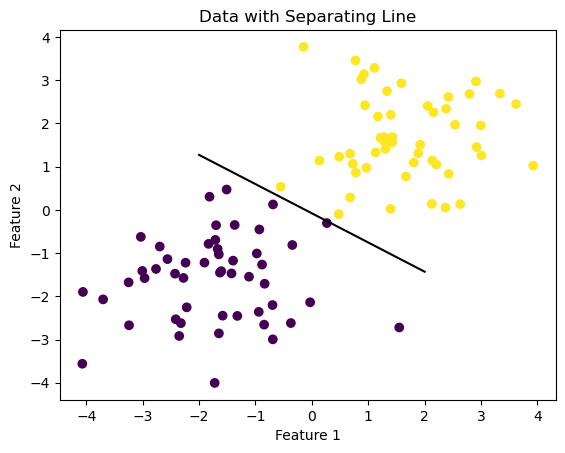
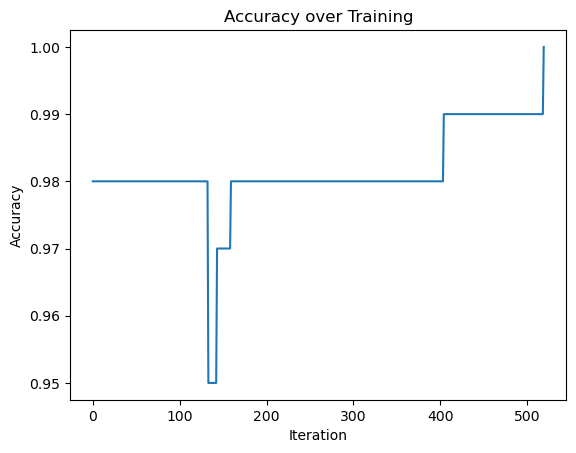
Experiment 2
In this experiment we also use 2d data, but not linearly separable, so that the perceptron algorithm will not converge to a weight vector \(\tilde{w}\) that describes a separating line. It is possible to see that in the accuracy graph, the perceptron algorihtm never reaches a perfect accuracy
n = 100
p_features = 3
X, y = make_blobs(n_samples = 100, n_features = p_features - 1, centers = [(0, 0), (0, 0)])
p = Perceptron()
p.fit(X, y, max_steps = 1000)
data_fig = plt.scatter(X[:,0], X[:,1], c = y)
data_fig = draw_line(p.w, -2, 2)
xlab = plt.xlabel("Feature 1")
ylab = plt.ylabel("Feature 2")
plt.title("Data with Separating Line")
plt.show()
accuracy_fig = plt.plot(p.history)
xlab = plt.xlabel("Iteration")
ylab = plt.ylabel("Accuracy")
plt.title("Accuracy over Training")
plt.show()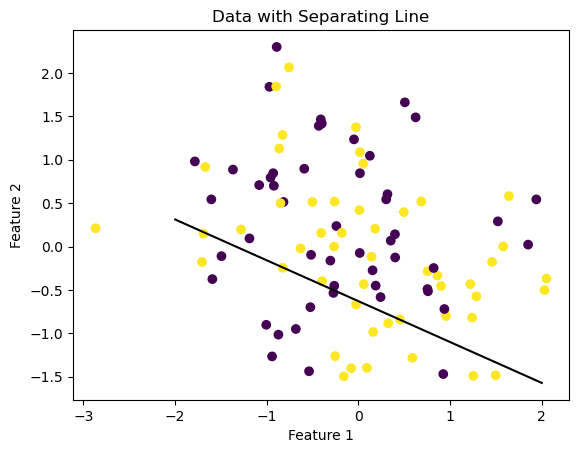
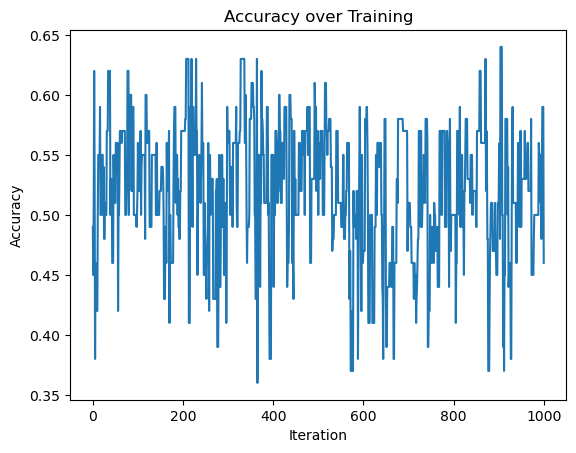
Experiment 3
In this experiment we try to apply the perceptron algorithm in more than 2 dimensions. Here we try 5 features:
n = 100
p_features = 5
X, y = make_blobs(n_samples = 100, n_features = p_features, centers = np.random.uniform(-1, 1, (2, p_features)))
p = Perceptron()
p.fit(X,y, max_steps = 1000)
accuracy_fig = plt.plot(p.history)
xlab = plt.xlabel("Iteration")
ylab = plt.ylabel("Accuracy")
plt.title("Accuracy over iterations")
plt.show()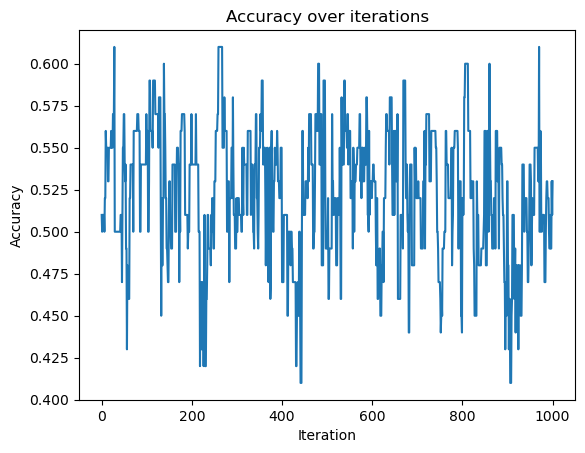
Based on the graph above, it does not seem that the data is linearly separable, as the accuracy does not seem to improve with the number of iterations making it unlikely that it will converge.
Writing
What is the runtime complexity of a single iteration of the perceptron algorithm update?
First, choosing a random index takes constant time. Updating the weights involves a dot product between a row vector and the current weigths, and since both have length \(p+1\) this takes \(O(p)\) time. Next, we call the score() function. This function first calls predict() which takes \(O(np)\) time as it involves matrix multiplication between a \(n \times p\) matrix and a \(p \times 1\) vector. Finally, the score() function iterates over it’s input, which is a vector of lenght \(n\), so overall this function takes \(O(np + n) = O(np)\) time. Hence, a single iteration of the perceptron algorithm update has a time complexity of \[O(p) + O(np) = O(np)\]